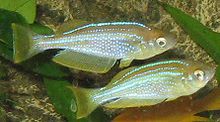
The Poeciliidae are a family of freshwater fishes of the order Cyprinodontiformes, the tooth-carps, and include well-known live-bearing aquarium fish, such as the guppy, molly, platy, and swordtail. The original distribution of the family was the Southeastern United States to north of Río de la Plata, Argentina, and Africa, including Madagascar. Due to release of aquarium specimens and the widespread use of species of the genera Poecilia and Gambusia for mosquito control, though, poeciliids can today be found in all tropical and subtropical areas of the world. In addition, Poecilia and Gambusia specimens have been identified in hot springs pools as far north as Banff, Alberta.
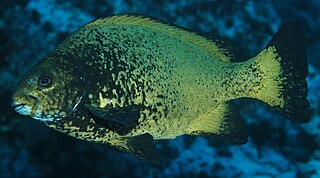
The sea chubs are a family, Kyphosidae, of fishes in the order Perciformes native to the Atlantic, Indian and Pacific Oceans usually close to shore in marine waters.

Fundulidae is the family of topminnows and North American killifishes.

Caranginae is a subfamily of ray-finned fish from the family Carangidae which consists of twenty genera and 103 species.

Tincinae is a subfamily of freshwater ray-finned fish from the family Cyprinidae, it consists of the tench of Eurasia and the east Asian clod minnows.

The oceanic basslets are ray-finned fish that belong to the small family Howellidae within the superfamily Percoidea of the suborder Percoidei part of the order Perciformes. The family includes about 9 species. They are mostly deep-water species, some of which move to shallower waters at night. Various species are found in the Indian Ocean, Pacific Ocean, including the Coral Sea, and Atlantic Ocean, including the Caribbean Sea.

Labriformes is an order of ray-finned fishes which includes the wrasse, cales and parrotfishes, within the clade Percomorpha. Some authors include the Labroformes as the clade Labroidei within the Perciformes while others include more families within the Labriformes, such as the cichlids and damselfishes, but the 5th edition of Fishes of the World includes just three listed in the section below and includes 87 genera and about 630 species.

Phallostethinae is a subfamily of fishes, one of two subfamilies in the family Phallostethidae, the priapumfishes. The species in this subfamily are characterised mainly by having highly protrusible jaws. The genus Neostethus appears to be the sister taxon to the other two genera in the subfamily. The species in the Phallostethinae are found in south-east Asia, the Malay Archipelago and the Philippines.

Cypsellurinae is a subfamily of flying fishes, one of four in the family Exocoetidae and the only one which is not monogeneric.

Procatopodinae is a subfamily of the family Poeciliidae, the "livebearers", in the order Cyprinodontiformes. Some authorities treat this subfamily as a family, the Procatopodidae, including the banded lampeye.

The Heterandriini is a tribe of killifishes from the "livebearer" family Poeciliidae, consisting of seven genera and around 50 species. The tribe was originally delineated by Carl Leavitt Hubbs in 1924.

The Poeciliini is a tribe of killifishes from the "livebearer" family Poeciliidae, consisting of six genera and just over 100 species.
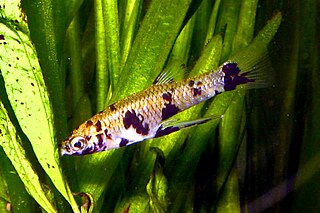
The Girardini is a tribe of killifishes from the "livebearer" family Poeciliidae, consisting of three genera and 10 species. The tribe was originally delineated by Carl Leavitt Hubbs in 1924.

Cnesterodontini is a tribe of fishes which are within the subfamily Poeciliinae of the family Poeciliidae. This tribe is distinguished from other tribes in the Poeciliinae by the males having five rays in the pelvic fin, there is a pedicle at the base of the third ray which joins it to the fourth ray, another pedicle at the third rays tip and a membrane there too.

Trachinotinae is a subfamily of the family Carangidae, the jacks and pompanos.
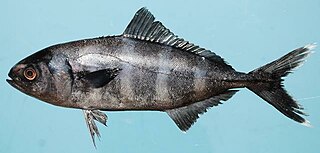
Naucratinae is a subfamily of ray-finned fish from the family Carangidae which consists of five genera and 13 species.

Luciocephalinae is a subfamily of the gourami family Osphronemidae. The members of this subfamily differ from the other groups within the gourami family by having a reduced number of rays supporting the branchiostegal membrane, five rather than six, and in the possession of a median process of the basioccipital which reaches the first vertebra and which has an attachment to the Baudelot’s ligament.

Epinephelini is one of the five tribes in the subfamily Epinephelinae, the groupers, which is part of the family Serranidae which also includes the anthias and the sea basses.
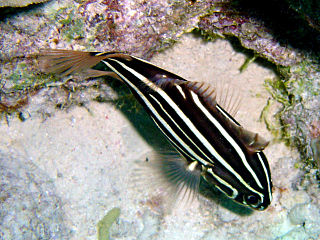
Grammistini is one of the five tribes in the subfamily Epinephelinae, the group including the groupers, which is part of the family Serranidae which also includes the anthias and the sea basses. They are found in tropical oceans around the world.

Romanichthyini is a tribe of freshwater ray-finned fish which is one of two tribes in the subfamily Luciopercinae, which in turn is classified under the family Percidae, the family also includes the perches, pikeperches, ruffes and darters.
